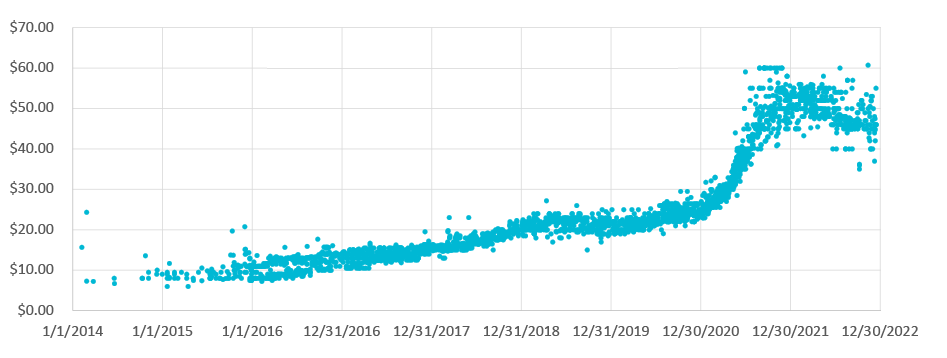Electric Cooperatives
& Broadband Expansion
by IPv4.Global Staff

In June of 2022, President Biden signed the American Rescue Plan.
Carved out in that bill is $25 billion in funding meant to expand access to affordable, high-speed internet. This funding was in addition to the $65 billion previously allocated to close the digital divide in the Bipartisan Infrastructure Law, with various other provisions, grants, loans, and incentive programs designed to reduce project costs and risks.
America’s electric cooperatives (co-ops)—whose original mission was to provide electricity to remote locales and have since expanded to providing high-speed internet—welcomed this news. Bills such as these would afford them the tools required to make the dream of high-speed, fiber-optic internet a reality for tens of millions of Americans.
Naturally, this massive broadband expansion will have downstream effects on the IPv4 market, particularly in terms of supply, demand, and pricing. But before delving into that topic, it is important to understand the role co-ops will play in the nationwide push for broadband expansion first.
What is an Electric Co-op?
Electric co-ops are a type of utility company owned and controlled by the people they serve.
These non-profits were formed for the express purpose of providing electricity (and now high-speed broadband internet) to rural or underserved areas, where it may not have otherwise been financially advantageous for a traditional investor-owned utility company to operate.
As a part of their charter, a co-op is required to fulfill the following requirements:
- Reinvest revenue or margins into the service area’s communities via infrastructure and predictable rates; or return revenue via patronage capital in the form of capital credits.
- Operate according to a democratic model, wherein the member-owners can vote in board elections and on directives, run for director spots, and generally participate in policy making.
According to the National Rural Electric Cooperative Association (NRECA), electric co-ops:
- Power 56% of the nation’s landmass, including more than 21 million businesses, homes, schools, and farms.
- Serve more than 42 million people, including 92% of persistent poverty counties
- Return more than $1.5 billion in capital credits to consumer-members annually
Why Are Electric Co-ops Receiving Broadband Expansion Funding?
Today, co-ops are uniquely positioned to serve the very communities these bills were created to address, which is why a significant portion of the funding will go to them.
But what specifically makes them the ideal candidates for spearheading the push for broadband expansion? Why are they the ones entrusted with billions of dollars in federal funding?
There are several reasons for making them the de facto leaders of this admirable cause, including:
- Commitment to the cause – Even before these additional funds were granted, in April 2021 NRECA CEO Jim Matheson said that 200 of the 900 electric cooperatives affiliated with the NRECA were already on the ground in these impacted communities, building relationships and expanding broadband. And now that additional funds have been secured, another 200 co-ops are assessing the feasibility of providing broadband to another 6,000,000 households.
- Locally owned and controlled – Because co-ops are owner-operated, they’re more closely attuned to the needs of their communities and members, which makes them more responsive to broadband demand in the area. And, because they’re non-profits, they can take a longer-term view toward infrastructure investments since they don’t face shareholder pressure to generate immediate returns.
- Existing infrastructure – In their mission to provide electricity to these communities, many of these co-ops already have made significant middle-mile fiber asset and infrastructure investments—such as power lines and poles. These can be leveraged for last-mile expansions to also deliver broadband services, thus reducing the cost and time necessary to roll out broadband services.
- Commitment to serve their communities – With traditional electrical and internet service providers (ISP), profits are the motivating factor for business decisions. But that’s not the case for electric co-ops, which are committed to serving their communities and closing the digital divide. As a result, they may be more willing to invest in broadband infrastructure and services, even in areas where financial returns are unlikely.
- Robust partnerships with policymakers – Policymakers in Washington have previously established working relationships with co-ops to improve broadband data collection to reveal gaps in coverage and better direct federal resources.
- Efficient with funds – Non-profit co-ops have already learned how to operate in a lean manner, making the most of every dollar granted to them. As such, they’re more agile—able to deploy projects quicker than a for-profit service provider.
- Transparency – Unlike many for-profit organizations, electric co-ops are more transparent when it comes to providing clear information about their broadband plan as it relates to pricing, speeds, fees, and data allowances. So, when the new broadband labels are officially released, co-ops will be better prepared to consent to the impending FCC labeling requirements.
So, what will they use these funds for?
As previously mentioned, the goal of this capital is to provide reliable, affordable, high-speed internet access to all Americans. But what this may look like will depend on the specific community and project.
For example, on May 13 Arkansas co-ops united to form the Diamond State Networks, which pledged to combine the fiber-optic networks of its members to increase bandwidth and save costs. This coop partnership is made up of 13 Arkansas electrical cooperatives, including OzarksGo, Clay County Connect, Farmers Electric Cooperative Corporation, Enlightened, etc[1] . The Diamond State Networks announced that it sought to invest more than $1.6bn in broadband communication infrastructure, exclusively in fiber-optic networks for more than 600,000 potential customer locations.
We can make another list here of all 13 if desired, but I figured listing some names and linking to the page of members that makes up Diamond State Networks would suffice
What Does This Mean for the IPv4 Market?
For regional co-ops, there are significant price and demand change implications on the horizon.
Even before the federal push for broadband expansion, IPv4 exhaustion was already a pressing concern. But now, more than 53% of regional ISPs expect to run out of IPv4 addresses needed to meet anticipated growth within the next three years.
Because of increasing demand and looming supply concerns, IPv4 prices have skyrocketed over the last decade.

IPv4 address price history from IPv4.Global
This trend in rising prices is unlikely to reverse in the near future. Now that electric co-ops will be sitting on billions of federal dollars, IPv4 price inflation is a strong likelihood.
Going forward, co-ops will need to carefully monitor the availability and prices of smaller IPv4 blocks. Seeing as they’re smaller companies, co-ops typically prefer to buy these smaller, cheaper blocks. But, with a likely increase in demand for smaller block sizes, it’s reasonable to assume that their prices may experience a concurrent rise.
Where Can I Follow This News?
For millions of underserved Americans, the expansion of broadband via electrical co-ops is an exciting prospect.
While we can speculate, the exact impacts such efforts will have on the IPv4 market remain shrouded in uncertainty. In the future, interested parties will need to keep a close eye on IPv4 prices and activities, as well as news related to broadband expansion efforts.
IPv4.Global is one of the best and most trusted sources for up-to-date industry news, online auctions, and private brokered solutions.
For more information on IPv4 auctions or news on IPv4 broadband expansion, visit https://ipv4.global/ to get connected.